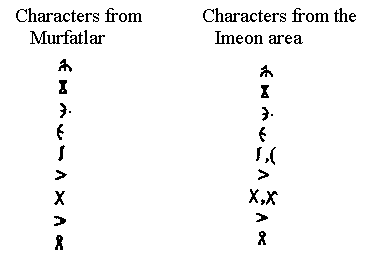5. The Key to the Inscriptions from Murfatlar
Most interesting in the inscriptions of Murfatlar is probably the ancient origin of their alphabet. Its oldest counterpart was found in the proximity of Imeon, i.e. in the area inhabited by the Proto-Bulgarians before their settling in Europe.
Renowned researchers, connoisseurs of the ancient writings, noticed this original alphabet a long time ago and already succeeded in its deciphering. They successfully tracked the way of this alphabet to Europe and its further development in the areas, where Kubrat Bulgaria was once situated. But all these important and long time ago established realities eluded the attention of the Bulgarian scholars so far. When the international science had already compiled interpretation tables of the alphabets of this type (which descend from some yet not well-known common alphabet), a multiplicity of unreasonable and fantastic ideas was born in Bulgaria: for example that the inscriptions in question were written in Chinese or Old Chinese hieroglyphs, in Turkic or Old Turkic runes, etc. Today some foreign scholars, above all these poorly informed about the writings of the east, fell in the same error.
The comparison of the alphabet from the mountains Imeon with that from
Murfatlar is sufficient to determine that these strange and confusing our
scholars characters like ![]() ,
regarded by many as Chinese hieroglyphics or proto-types of the Chinese
alphabet, are somewhat quite prosaic and well known since a long time:
,
regarded by many as Chinese hieroglyphics or proto-types of the Chinese
alphabet, are somewhat quite prosaic and well known since a long time:
Most important similarities:

The key to the inscriptions was neither discovered nor invented in Murfatlar. It existed a long time ago. Had not been the one-sided development of our Orientalistics, its leaning towards the Turkic studies and its neglecting of the study of the entire East, the mystery of the Proto-Bulgarian inscriptions would have been solved much earlier. Unfortunately, the biased nature of the investigations in the past and the desire to read the inscriptions unconditionally in either Turkic or Chinese interrupted the advance in this interesting area and transformed the Proto-Bulgarian runes into an unsolvable mystery
Relying on the already published eastern alphabet of Murfatlar's type (see the most complete by so far list of similarities between the alphabet from Imeon, that from Kubrat Bulgaria, and that from Bulgaria), we are free to read almost all undeciphered inscriptions.
In order to understand even better their nature is it appropriate to focus our attention on the inscriptions with repeating special features. For example, two inscriptions end with a word consisting of a single character - the character E. A third inscription ends likewise with a word consisting of only one character - the character IU. These short words obviously were characteristic to the Bulgarian language.
Comparison of the alphabets from the three main areas,
once inhabited by Proto-Bulgarians (full list of the
analogies).

Such single letters occur two or three times at the end of the Proto-Bulgarian inscriptions with Greek letters, particularly the letter E in expressions such as ASO E (ash is, dust is). Therefore, the ending E in the runic inscriptions is probably not different from the Indo-Iranian form E (AE, HAE), already mentioned during the discussion of the first group of inscriptions. The other ending IU is also characteristic for the same language group. It is the third person, plural form of the verb TO BE and is generally identical to our word. Besides the Indo-Iranian, a similar grammatical form is found also in some Celtic languages. Furthermore, we see that the first words in the inscriptions often end on "i" and "e", endings characteristic to the eastern Iranian languages.
The grammar of the Runic inscriptions is identical to the Proto-Bulgarian inscriptions with Greek letters. Both were written by the same people, the people that once lived in the area of Imeon (Pamir).
[Previous] [Next]
[Back to Contents]